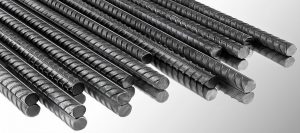DESIRABLE PROPERTIES OF STEEL BARS
8 Properties of steel bars

The following are the desirable properties of the steel bars that we must look at the site in the steel.
Tensile strength:
1: The strength of the CTD bar is 415, 500 and 550 N/mm2.
2: The ultimate strength of the bar is at least 10-15% more than the yield strength of the bar.
3: The CTD bars are very useful for structural engineers because of its strength.
Bond strength:
1: Bonds in concrete and steel depends on the deformation of the ribbing pattern over the bars.
2: The slipping characteristics of deformed bars are 0.1 mm.
3: The longitudinal ribs over the bar to increase the bond strength at about 3 to 4 times of the plain bars.
4: Longitudinal ribs and oblique lugs are provided in the bars.
Ductility:
For better performance ductility is an important criterion especially during the earthquake loading.
1: The extension of the steel bar at the rapture over a standard gauge length is acceptable.
2: The percentage of elongation in steel has not been less than 14.5%.
Bend ability:
It is another important feature for reinforcing bars, in the view of cracking, 90 degrees bending of bars which are required during the reinforcement fabrication.
1: The bendability of the bar will be reduced due to the ribs and lugs on the bars
2: In CTD bars the lugs and ribs are designed in that way to make uniform streamline effect.
3: The lugs merged into the core of the bar and do not run in the longitudinal ribs.
4: The CTD bars have a good bendability because there is no notch effect and the closely controlled chemistry of the steel.
Weldability:
CTD bare are formed with less range of carbon and the maximum equivalent of 0.42%.
1: This bar can weld without the need of special electrodes.
Fatigue strength:
Reinforced concrete produces minimum and maximum stresses and may fail due to fatigue in steel.
Generally in the concrete structures, The stress due to dead load is about half of the total stress. So the fatigue need not to be considered during the design process.
Corrosion resistance:
Protection against corrosion resistance results to cement slurry coating around it.
According to surveys the corrosion takes place in the structures due to faulty design or error in construction.
Larger width crack in the tensile zone results in the damage of protective slurry coating around bars.
Under the extreme conditions, the different test reveals that no corrosion occurs with the crack width of 0.1 mm or 0.2 mm.
During storage of steel
1: Storage is generally associated with weight loss of not more than 1 – 3%.
2: Corrosion does not affect concrete bond characteristics.
Fire Resistance:
If temperature is 500 – 600 degrees than reinforcement concrete structure will be affected.
At that extreme temperature the CTD bars strength reduces and becomes weaker to about 250 N/mm2, which is the level of actual stress of Fe 415.
